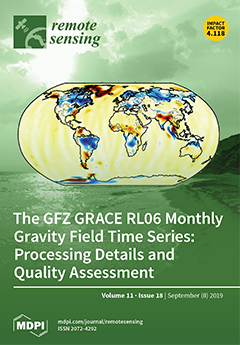The airborne AirSWOT instrument suite, consisting of an interferometric Ka-band synthetic aperture radar and color-infrared (CIR) camera, was deployed to northern North America in July and August 2017 as part of the NASA Arctic-Boreal Vulnerability Experiment (ABoVE). We present validated, open (i.e., vegetation-free)
[...] Read more.
The airborne AirSWOT instrument suite, consisting of an interferometric Ka-band synthetic aperture radar and color-infrared (CIR) camera, was deployed to northern North America in July and August 2017 as part of the NASA Arctic-Boreal Vulnerability Experiment (ABoVE). We present validated, open (i.e., vegetation-free) surface water masks produced from high-resolution (1 m), co-registered AirSWOT CIR imagery using a semi-automated, object-based water classification. The imagery and resulting high-resolution water masks are available as open-access datasets and support interpretation of AirSWOT radar and other coincident ABoVE image products, including LVIS, UAVSAR, AIRMOSS, AVIRIS-NG, and CFIS. These synergies offer promising potential for multi-sensor analysis of Arctic-Boreal surface water bodies. In total, 3167 km
2 of open surface water were mapped from 23,380 km
2 of flight lines spanning 23 degrees of latitude and broad environmental gradients. Detected water body sizes range from 0.00004 km
2 (40 m
2) to 15 km
2. Power-law extrapolations are commonly used to estimate the abundance of small lakes from coarser resolution imagery, and our mapped water bodies followed power-law distributions, but only for water bodies greater than 0.34 (±0.13) km
2 in area. For water bodies exceeding this size threshold, the coefficients of power-law fits vary for different Arctic-Boreal physiographic terrains (wetland, prairie pothole, lowland river valley, thermokarst, and Canadian Shield). Thus, direct mapping using high-resolution imagery remains the most accurate way to estimate the abundance of small surface water bodies. We conclude that empirical scaling relationships, useful for estimating total trace gas exchange and aquatic habitats on Arctic-Boreal landscapes, are uniquely enabled by high-resolution AirSWOT-like mappings and automated detection methods such as those developed here.
Full article





